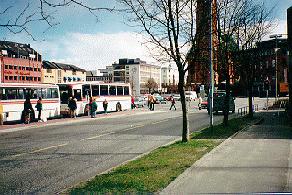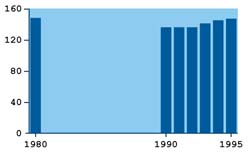Public transport in 1000 km. Source: Statistics Norway: Nordic Environmental Indicators.
 Measures to reduce the effects of noise from road traffic include screening people from noise by building noise barriers and insulating windows and walls. However, such measures simultaneously increase the barrier effect of the roads.
Measures to reduce the effects of noise from road traffic include screening people from noise by building noise barriers and insulating windows and walls. However, such measures simultaneously increase the barrier effect of the roads. In the directives for noise from traffic, limits for acceptable strain from noise have been given:
| Average level of noise over 24 hours: | |
| Outdoors | 55-60 desibel |
| Indoors | 30-35 decibel |
These limits concern planning of new dwellings and roads.
For new dwellings, the highest level of noise from the outside is limited to 30 decibel.
Public transportation
 Environmental problems can be reduced by e.g. encouraging increased use of public transport and bicycles, reducing private driving in residential areas by building physical obstacles and improve the combustion technology of the vehicles’ engines. Gradually increasing the use of electric vehicles would also reduce the problem.
Environmental problems can be reduced by e.g. encouraging increased use of public transport and bicycles, reducing private driving in residential areas by building physical obstacles and improve the combustion technology of the vehicles’ engines. Gradually increasing the use of electric vehicles would also reduce the problem.
The number of vehicle-kilometres of public transport seems to have varied very little since the mid-1970s. The number of public transport passengers has increased slightly during the last years. In 1990, 136 million single trips were registered, with an increase to 147 million single trips in 1995 (Source: Oslo Sporveier).
The figures cover buses, trams and underground trains and apply to Oslo municipality.
Public transport single trips in the Oslo region in millions.
|
 |